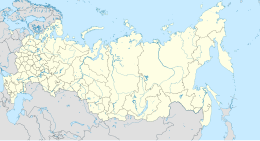Novaya Sibir
| Native name: Но́вая Сиби́рь | |
|---|---|

Location of New Siberia in the Anzhu subgroup
|
|
| Geography | |
| Location | between the Laptev Sea and East Siberian Sea |
| Coordinates | 75°05′14″N 148°27′30″E / 75.08722°N 148.45833°E |
| Archipelago | New Siberian Islands |
| Area | 6,200 km2 (2,400 sq mi) |
| Highest elevation | 76 m (249 ft) |
| Highest point | unnamed |
| Administration | |
|
Russia
|
|
| Territory | Sakha (Yakutia) Republic |
New Siberia (Russian: Но́вая Сиби́рь; English transliteration: Novaya Sibir) is the easternmost of the Anzhu Islands, the northern subgroup of the New Siberian Islands lying between the Laptev Sea and East Siberian Sea. Its area of approximately 6,200 square kilometres (2,394 square miles) places it just outside the 100 largest islands in the world. New Siberia Island is low lying, rising to only 76 metres (249 feet) and covered with tundra vegetation. The island is a part of the territory of the Sakha (Yakutia) Republic of Russia.
The fact that this island is called "New Siberia" and is located in the "New Siberian Islands" could cause some confusion.
New Siberia Island consists of clastic sediments ranging from Late Cretaceous to in age. The Late Cretaceous sediments consist of extensively folded layers of gray and greenish gray tuffaceous sand, tuffaceous silt, pebbly sand, and layers of brown coal exposed in sea cliffs along it southwest coast. The sand and silt often contain either volcanic glass, fossil plants, rhyolite pebbles, or some combination of them. Eocene sand, silt, clay, and brown coal overlies an erosional unconformity cut into the Late Cretaceous sediments. Within the northwest part of New Siberia Island, these sediments grade into clays that contain fragments of marine bivalves. Directly overlying the Eocene sediments and another erosional unconformity are sands of Oligocene and Early Miocene age. They contain thin beds of silt, mud, clay, and pebbles. These sands contain fossil plants and lagoonal, swamp, and lacustrine diatoms. These sands are overlain by Pliocene sediments consisting of layers of sand, silt, mud, peat, and pebbles.
...
Wikipedia

